Leadership in Clinical Practice: Addressing Manual Handling Issues in Hospitals
VerifiedAdded on 2023/06/11
|11
|3095
|175
AI Summary
The essay discusses the issue of manual handling in hospitals and the impact of nursing leadership on this issue from clinical practice. Effective leadership in clinical practice can address the issue of manual handling in hospitals and related injuries. The essay also discusses the barriers in the process of change required to minimize the issue.
Contribute Materials
Your contribution can guide someone’s learning journey. Share your
documents today.
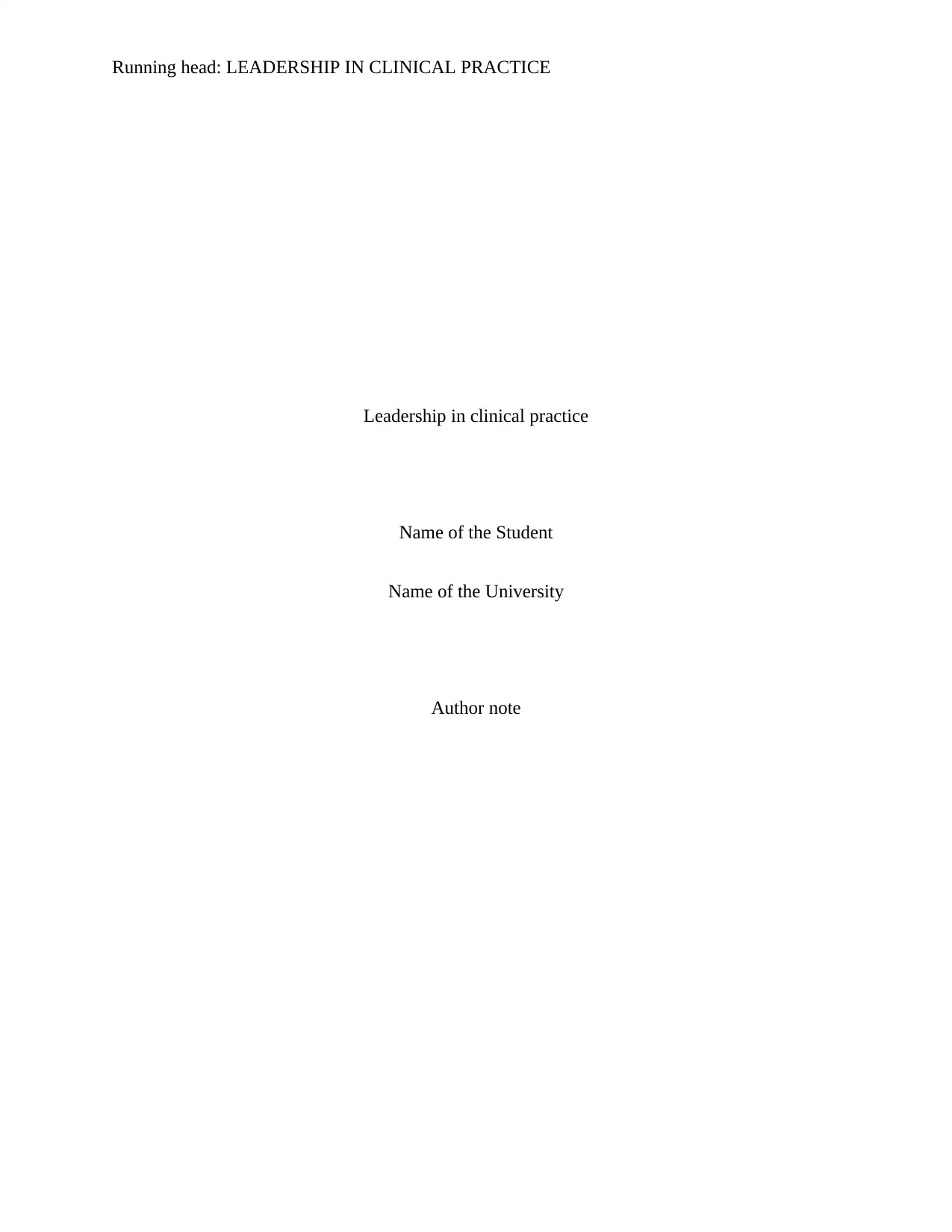
Running head: LEADERSHIP IN CLINICAL PRACTICE
Leadership in clinical practice
Name of the Student
Name of the University
Author note
Leadership in clinical practice
Name of the Student
Name of the University
Author note
Secure Best Marks with AI Grader
Need help grading? Try our AI Grader for instant feedback on your assignments.
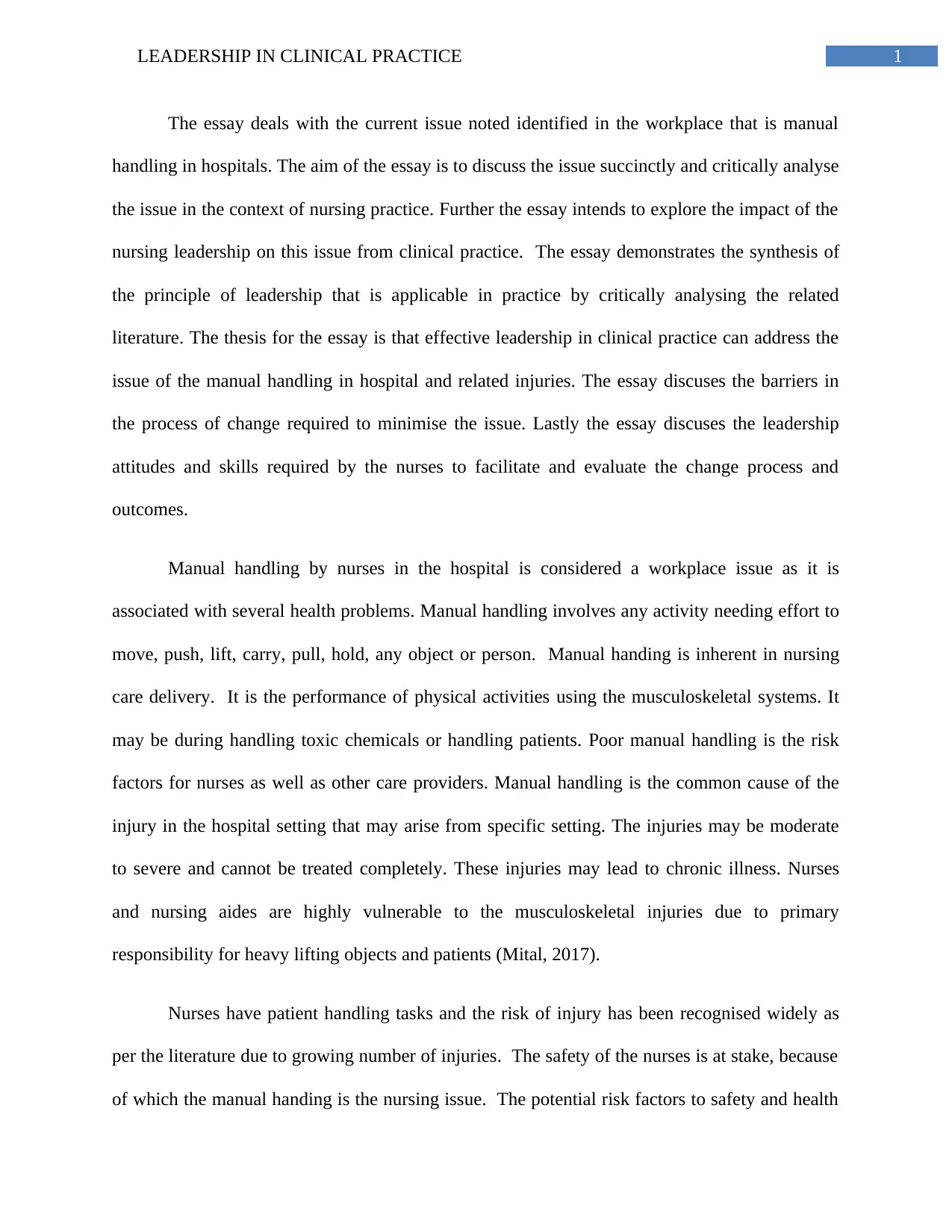
1LEADERSHIP IN CLINICAL PRACTICE
The essay deals with the current issue noted identified in the workplace that is manual
handling in hospitals. The aim of the essay is to discuss the issue succinctly and critically analyse
the issue in the context of nursing practice. Further the essay intends to explore the impact of the
nursing leadership on this issue from clinical practice. The essay demonstrates the synthesis of
the principle of leadership that is applicable in practice by critically analysing the related
literature. The thesis for the essay is that effective leadership in clinical practice can address the
issue of the manual handling in hospital and related injuries. The essay discuses the barriers in
the process of change required to minimise the issue. Lastly the essay discuses the leadership
attitudes and skills required by the nurses to facilitate and evaluate the change process and
outcomes.
Manual handling by nurses in the hospital is considered a workplace issue as it is
associated with several health problems. Manual handling involves any activity needing effort to
move, push, lift, carry, pull, hold, any object or person. Manual handing is inherent in nursing
care delivery. It is the performance of physical activities using the musculoskeletal systems. It
may be during handling toxic chemicals or handling patients. Poor manual handling is the risk
factors for nurses as well as other care providers. Manual handling is the common cause of the
injury in the hospital setting that may arise from specific setting. The injuries may be moderate
to severe and cannot be treated completely. These injuries may lead to chronic illness. Nurses
and nursing aides are highly vulnerable to the musculoskeletal injuries due to primary
responsibility for heavy lifting objects and patients (Mital, 2017).
Nurses have patient handling tasks and the risk of injury has been recognised widely as
per the literature due to growing number of injuries. The safety of the nurses is at stake, because
of which the manual handing is the nursing issue. The potential risk factors to safety and health
The essay deals with the current issue noted identified in the workplace that is manual
handling in hospitals. The aim of the essay is to discuss the issue succinctly and critically analyse
the issue in the context of nursing practice. Further the essay intends to explore the impact of the
nursing leadership on this issue from clinical practice. The essay demonstrates the synthesis of
the principle of leadership that is applicable in practice by critically analysing the related
literature. The thesis for the essay is that effective leadership in clinical practice can address the
issue of the manual handling in hospital and related injuries. The essay discuses the barriers in
the process of change required to minimise the issue. Lastly the essay discuses the leadership
attitudes and skills required by the nurses to facilitate and evaluate the change process and
outcomes.
Manual handling by nurses in the hospital is considered a workplace issue as it is
associated with several health problems. Manual handling involves any activity needing effort to
move, push, lift, carry, pull, hold, any object or person. Manual handing is inherent in nursing
care delivery. It is the performance of physical activities using the musculoskeletal systems. It
may be during handling toxic chemicals or handling patients. Poor manual handling is the risk
factors for nurses as well as other care providers. Manual handling is the common cause of the
injury in the hospital setting that may arise from specific setting. The injuries may be moderate
to severe and cannot be treated completely. These injuries may lead to chronic illness. Nurses
and nursing aides are highly vulnerable to the musculoskeletal injuries due to primary
responsibility for heavy lifting objects and patients (Mital, 2017).
Nurses have patient handling tasks and the risk of injury has been recognised widely as
per the literature due to growing number of injuries. The safety of the nurses is at stake, because
of which the manual handing is the nursing issue. The potential risk factors to safety and health

2LEADERSHIP IN CLINICAL PRACTICE
in nurses handling tasks manually include weight, distance, posture and other risky tasks (Bernal
et al., 2015). Weight refers to moving adult patients with limited mobility and assists them that
may cause injuries due to overexertion and stress. Factors like drip stands, bed rails, furniture,
wheel chairs separate the worker from the patient causing injuries. Awkward position or posture
may result in the musculoskeletal disorders. The highly risky tasks includes moving a hostile
person, totally dependent patients, lifting patients from floor, transferring the patients from bed
to chair and to other locations. Repositioning a patient in chair or bed or bathing and assisting
disabled person into a vehicle. Other factors contributing to the manual handling and associated
injuries slippery floor, inadequate lightening, spillage of chemicals, fatigue due to repeated
manual handling (Teeple et al., 2017).
The contributors of injuries due to manual handling in nursing practice includes slips,
trips, and falls, muscular stress as objects are not handled, annual handing of trolleys, adjustment
of beds, handling of lead aprons, and linen. The main type of manual handing injury has been
found to be sprains and strains. Among the registered nurses the 40% of the injuries include
back, 9 per cent the lower limbs, 12 per cent the upper limbs. In the patient handling activities
the injuries mainly involved beds such as repositioning and transferring patients. These injures
are even common if the nurses are working in the aged care facility (Kneafsey et al., 2015).
These injuries may hamper the work efficiency of the nurses and implies for change in
workplace that will address the issue. Psychological risk factors were found to be associated
with the manual handling injuries. Psychological changes such as immune system responses,
endocrine response, and muscle tension. Psychological risks for the musculoskeletal disorder
include high work pressure with little rewards, lack of autonomy over work, and tight deadlines
(Bernal et al., 2015). Over the time the psychological risk factors may develop as mental health
in nurses handling tasks manually include weight, distance, posture and other risky tasks (Bernal
et al., 2015). Weight refers to moving adult patients with limited mobility and assists them that
may cause injuries due to overexertion and stress. Factors like drip stands, bed rails, furniture,
wheel chairs separate the worker from the patient causing injuries. Awkward position or posture
may result in the musculoskeletal disorders. The highly risky tasks includes moving a hostile
person, totally dependent patients, lifting patients from floor, transferring the patients from bed
to chair and to other locations. Repositioning a patient in chair or bed or bathing and assisting
disabled person into a vehicle. Other factors contributing to the manual handling and associated
injuries slippery floor, inadequate lightening, spillage of chemicals, fatigue due to repeated
manual handling (Teeple et al., 2017).
The contributors of injuries due to manual handling in nursing practice includes slips,
trips, and falls, muscular stress as objects are not handled, annual handing of trolleys, adjustment
of beds, handling of lead aprons, and linen. The main type of manual handing injury has been
found to be sprains and strains. Among the registered nurses the 40% of the injuries include
back, 9 per cent the lower limbs, 12 per cent the upper limbs. In the patient handling activities
the injuries mainly involved beds such as repositioning and transferring patients. These injures
are even common if the nurses are working in the aged care facility (Kneafsey et al., 2015).
These injuries may hamper the work efficiency of the nurses and implies for change in
workplace that will address the issue. Psychological risk factors were found to be associated
with the manual handling injuries. Psychological changes such as immune system responses,
endocrine response, and muscle tension. Psychological risks for the musculoskeletal disorder
include high work pressure with little rewards, lack of autonomy over work, and tight deadlines
(Bernal et al., 2015). Over the time the psychological risk factors may develop as mental health

3LEADERSHIP IN CLINICAL PRACTICE
issues. Thus, change is required to prevent mental health issues among nurses due to manual
handling and prevent decreases in work productivity. Change is required to improve the care
quality and patient’s health outcomes.
On analysing the issue, manual handling comes with risk of chemical, biological, and
physical hazards. Change is required as the increases in rate of injuries will leads to the nurse
turn over. If a hospital already has a shortage of nurses then nurse absenteeism and turnover may
cause fall in the care quality. Workplace change is required to prevent the workplace injury due
to heavy lifting and other risky manual activities. Change is required to modify the nursing
activities and restructure the working environment in a manner that will reduce the occupational
injury. Educational based approach will help the nurses develop the injury prevention strategies.
Other strategies of change include regular risk assessment, feedback from nurses and
implementation of evidence based strategies. With such change the nurse can not only protect
themselves but also protect the patients from trips and falls. Change is thus required to improve
the patient’s satisfaction and ensure patient safety care (Kay, Evans & Glass, 2015).
There are several barriers to change and reduction of injuries associated with the manual
handling. It includes lack of adequate training program on safe work skills, inappropriate work
design, as well as incorrect beliefs and attitude towards the safe work performance. Tainting is
important to help employees recognise the risks and hazards associated with the manual
handlings and ways to deal with it. Training helps build relevant knowledge, attitudes and skills
and translate the same into workplace. Lack of nurses’ training on manual handling leads to poor
awareness on safety, use of mechanical aids, and negative attitude towards change (Akbari et al.,
2017). Lack of the ergonomic approaches in the workplace such as “no lift policy” is additional
barriers. Implementing such policies will lead to change in the issue. Hospitals lacking
issues. Thus, change is required to prevent mental health issues among nurses due to manual
handling and prevent decreases in work productivity. Change is required to improve the care
quality and patient’s health outcomes.
On analysing the issue, manual handling comes with risk of chemical, biological, and
physical hazards. Change is required as the increases in rate of injuries will leads to the nurse
turn over. If a hospital already has a shortage of nurses then nurse absenteeism and turnover may
cause fall in the care quality. Workplace change is required to prevent the workplace injury due
to heavy lifting and other risky manual activities. Change is required to modify the nursing
activities and restructure the working environment in a manner that will reduce the occupational
injury. Educational based approach will help the nurses develop the injury prevention strategies.
Other strategies of change include regular risk assessment, feedback from nurses and
implementation of evidence based strategies. With such change the nurse can not only protect
themselves but also protect the patients from trips and falls. Change is thus required to improve
the patient’s satisfaction and ensure patient safety care (Kay, Evans & Glass, 2015).
There are several barriers to change and reduction of injuries associated with the manual
handling. It includes lack of adequate training program on safe work skills, inappropriate work
design, as well as incorrect beliefs and attitude towards the safe work performance. Tainting is
important to help employees recognise the risks and hazards associated with the manual
handlings and ways to deal with it. Training helps build relevant knowledge, attitudes and skills
and translate the same into workplace. Lack of nurses’ training on manual handling leads to poor
awareness on safety, use of mechanical aids, and negative attitude towards change (Akbari et al.,
2017). Lack of the ergonomic approaches in the workplace such as “no lift policy” is additional
barriers. Implementing such policies will lead to change in the issue. Hospitals lacking
Secure Best Marks with AI Grader
Need help grading? Try our AI Grader for instant feedback on your assignments.
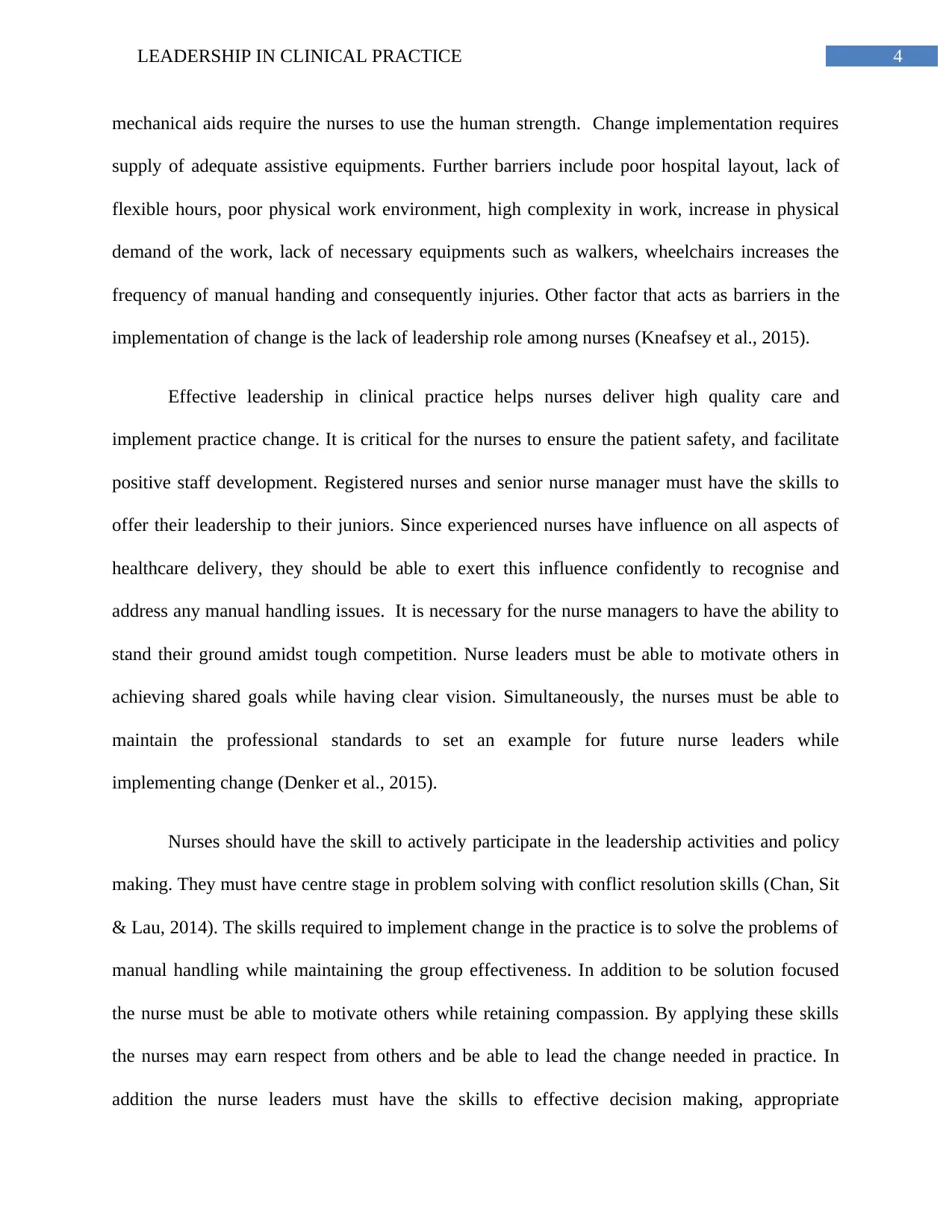
4LEADERSHIP IN CLINICAL PRACTICE
mechanical aids require the nurses to use the human strength. Change implementation requires
supply of adequate assistive equipments. Further barriers include poor hospital layout, lack of
flexible hours, poor physical work environment, high complexity in work, increase in physical
demand of the work, lack of necessary equipments such as walkers, wheelchairs increases the
frequency of manual handing and consequently injuries. Other factor that acts as barriers in the
implementation of change is the lack of leadership role among nurses (Kneafsey et al., 2015).
Effective leadership in clinical practice helps nurses deliver high quality care and
implement practice change. It is critical for the nurses to ensure the patient safety, and facilitate
positive staff development. Registered nurses and senior nurse manager must have the skills to
offer their leadership to their juniors. Since experienced nurses have influence on all aspects of
healthcare delivery, they should be able to exert this influence confidently to recognise and
address any manual handling issues. It is necessary for the nurse managers to have the ability to
stand their ground amidst tough competition. Nurse leaders must be able to motivate others in
achieving shared goals while having clear vision. Simultaneously, the nurses must be able to
maintain the professional standards to set an example for future nurse leaders while
implementing change (Denker et al., 2015).
Nurses should have the skill to actively participate in the leadership activities and policy
making. They must have centre stage in problem solving with conflict resolution skills (Chan, Sit
& Lau, 2014). The skills required to implement change in the practice is to solve the problems of
manual handling while maintaining the group effectiveness. In addition to be solution focused
the nurse must be able to motivate others while retaining compassion. By applying these skills
the nurses may earn respect from others and be able to lead the change needed in practice. In
addition the nurse leaders must have the skills to effective decision making, appropriate
mechanical aids require the nurses to use the human strength. Change implementation requires
supply of adequate assistive equipments. Further barriers include poor hospital layout, lack of
flexible hours, poor physical work environment, high complexity in work, increase in physical
demand of the work, lack of necessary equipments such as walkers, wheelchairs increases the
frequency of manual handing and consequently injuries. Other factor that acts as barriers in the
implementation of change is the lack of leadership role among nurses (Kneafsey et al., 2015).
Effective leadership in clinical practice helps nurses deliver high quality care and
implement practice change. It is critical for the nurses to ensure the patient safety, and facilitate
positive staff development. Registered nurses and senior nurse manager must have the skills to
offer their leadership to their juniors. Since experienced nurses have influence on all aspects of
healthcare delivery, they should be able to exert this influence confidently to recognise and
address any manual handling issues. It is necessary for the nurse managers to have the ability to
stand their ground amidst tough competition. Nurse leaders must be able to motivate others in
achieving shared goals while having clear vision. Simultaneously, the nurses must be able to
maintain the professional standards to set an example for future nurse leaders while
implementing change (Denker et al., 2015).
Nurses should have the skill to actively participate in the leadership activities and policy
making. They must have centre stage in problem solving with conflict resolution skills (Chan, Sit
& Lau, 2014). The skills required to implement change in the practice is to solve the problems of
manual handling while maintaining the group effectiveness. In addition to be solution focused
the nurse must be able to motivate others while retaining compassion. By applying these skills
the nurses may earn respect from others and be able to lead the change needed in practice. In
addition the nurse leaders must have the skills to effective decision making, appropriate
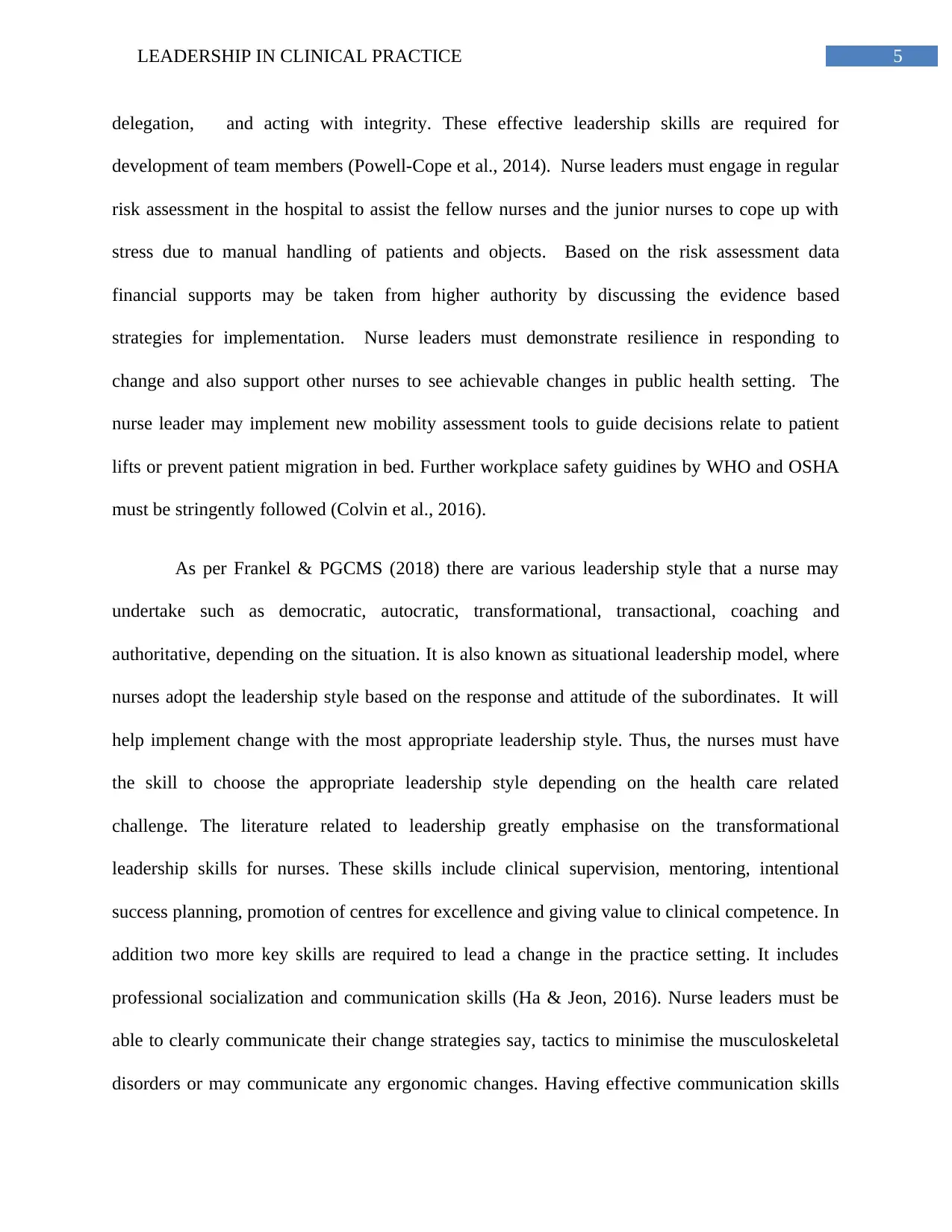
5LEADERSHIP IN CLINICAL PRACTICE
delegation, and acting with integrity. These effective leadership skills are required for
development of team members (Powell-Cope et al., 2014). Nurse leaders must engage in regular
risk assessment in the hospital to assist the fellow nurses and the junior nurses to cope up with
stress due to manual handling of patients and objects. Based on the risk assessment data
financial supports may be taken from higher authority by discussing the evidence based
strategies for implementation. Nurse leaders must demonstrate resilience in responding to
change and also support other nurses to see achievable changes in public health setting. The
nurse leader may implement new mobility assessment tools to guide decisions relate to patient
lifts or prevent patient migration in bed. Further workplace safety guidines by WHO and OSHA
must be stringently followed (Colvin et al., 2016).
As per Frankel & PGCMS (2018) there are various leadership style that a nurse may
undertake such as democratic, autocratic, transformational, transactional, coaching and
authoritative, depending on the situation. It is also known as situational leadership model, where
nurses adopt the leadership style based on the response and attitude of the subordinates. It will
help implement change with the most appropriate leadership style. Thus, the nurses must have
the skill to choose the appropriate leadership style depending on the health care related
challenge. The literature related to leadership greatly emphasise on the transformational
leadership skills for nurses. These skills include clinical supervision, mentoring, intentional
success planning, promotion of centres for excellence and giving value to clinical competence. In
addition two more key skills are required to lead a change in the practice setting. It includes
professional socialization and communication skills (Ha & Jeon, 2016). Nurse leaders must be
able to clearly communicate their change strategies say, tactics to minimise the musculoskeletal
disorders or may communicate any ergonomic changes. Having effective communication skills
delegation, and acting with integrity. These effective leadership skills are required for
development of team members (Powell-Cope et al., 2014). Nurse leaders must engage in regular
risk assessment in the hospital to assist the fellow nurses and the junior nurses to cope up with
stress due to manual handling of patients and objects. Based on the risk assessment data
financial supports may be taken from higher authority by discussing the evidence based
strategies for implementation. Nurse leaders must demonstrate resilience in responding to
change and also support other nurses to see achievable changes in public health setting. The
nurse leader may implement new mobility assessment tools to guide decisions relate to patient
lifts or prevent patient migration in bed. Further workplace safety guidines by WHO and OSHA
must be stringently followed (Colvin et al., 2016).
As per Frankel & PGCMS (2018) there are various leadership style that a nurse may
undertake such as democratic, autocratic, transformational, transactional, coaching and
authoritative, depending on the situation. It is also known as situational leadership model, where
nurses adopt the leadership style based on the response and attitude of the subordinates. It will
help implement change with the most appropriate leadership style. Thus, the nurses must have
the skill to choose the appropriate leadership style depending on the health care related
challenge. The literature related to leadership greatly emphasise on the transformational
leadership skills for nurses. These skills include clinical supervision, mentoring, intentional
success planning, promotion of centres for excellence and giving value to clinical competence. In
addition two more key skills are required to lead a change in the practice setting. It includes
professional socialization and communication skills (Ha & Jeon, 2016). Nurse leaders must be
able to clearly communicate their change strategies say, tactics to minimise the musculoskeletal
disorders or may communicate any ergonomic changes. Having effective communication skills
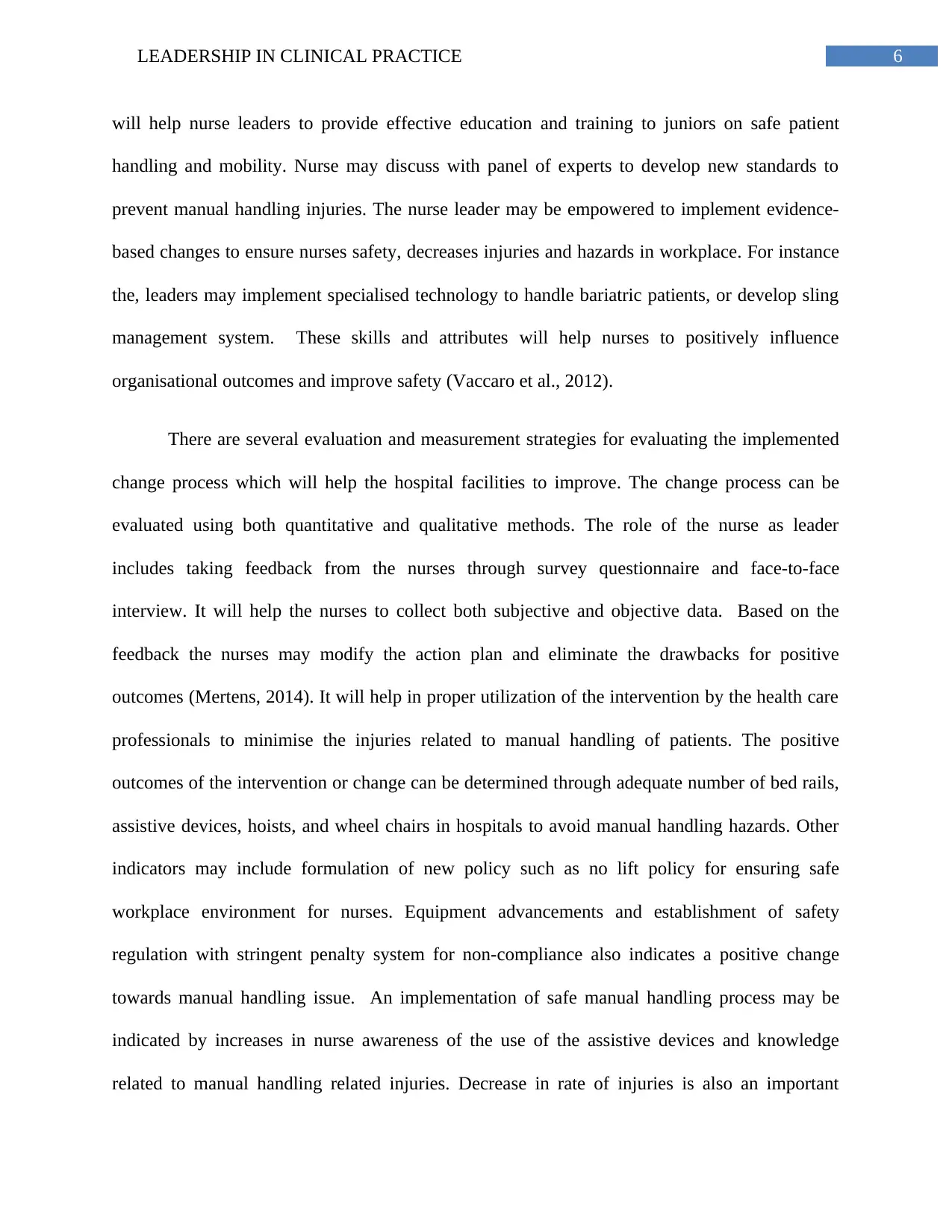
6LEADERSHIP IN CLINICAL PRACTICE
will help nurse leaders to provide effective education and training to juniors on safe patient
handling and mobility. Nurse may discuss with panel of experts to develop new standards to
prevent manual handling injuries. The nurse leader may be empowered to implement evidence-
based changes to ensure nurses safety, decreases injuries and hazards in workplace. For instance
the, leaders may implement specialised technology to handle bariatric patients, or develop sling
management system. These skills and attributes will help nurses to positively influence
organisational outcomes and improve safety (Vaccaro et al., 2012).
There are several evaluation and measurement strategies for evaluating the implemented
change process which will help the hospital facilities to improve. The change process can be
evaluated using both quantitative and qualitative methods. The role of the nurse as leader
includes taking feedback from the nurses through survey questionnaire and face-to-face
interview. It will help the nurses to collect both subjective and objective data. Based on the
feedback the nurses may modify the action plan and eliminate the drawbacks for positive
outcomes (Mertens, 2014). It will help in proper utilization of the intervention by the health care
professionals to minimise the injuries related to manual handling of patients. The positive
outcomes of the intervention or change can be determined through adequate number of bed rails,
assistive devices, hoists, and wheel chairs in hospitals to avoid manual handling hazards. Other
indicators may include formulation of new policy such as no lift policy for ensuring safe
workplace environment for nurses. Equipment advancements and establishment of safety
regulation with stringent penalty system for non-compliance also indicates a positive change
towards manual handling issue. An implementation of safe manual handling process may be
indicated by increases in nurse awareness of the use of the assistive devices and knowledge
related to manual handling related injuries. Decrease in rate of injuries is also an important
will help nurse leaders to provide effective education and training to juniors on safe patient
handling and mobility. Nurse may discuss with panel of experts to develop new standards to
prevent manual handling injuries. The nurse leader may be empowered to implement evidence-
based changes to ensure nurses safety, decreases injuries and hazards in workplace. For instance
the, leaders may implement specialised technology to handle bariatric patients, or develop sling
management system. These skills and attributes will help nurses to positively influence
organisational outcomes and improve safety (Vaccaro et al., 2012).
There are several evaluation and measurement strategies for evaluating the implemented
change process which will help the hospital facilities to improve. The change process can be
evaluated using both quantitative and qualitative methods. The role of the nurse as leader
includes taking feedback from the nurses through survey questionnaire and face-to-face
interview. It will help the nurses to collect both subjective and objective data. Based on the
feedback the nurses may modify the action plan and eliminate the drawbacks for positive
outcomes (Mertens, 2014). It will help in proper utilization of the intervention by the health care
professionals to minimise the injuries related to manual handling of patients. The positive
outcomes of the intervention or change can be determined through adequate number of bed rails,
assistive devices, hoists, and wheel chairs in hospitals to avoid manual handling hazards. Other
indicators may include formulation of new policy such as no lift policy for ensuring safe
workplace environment for nurses. Equipment advancements and establishment of safety
regulation with stringent penalty system for non-compliance also indicates a positive change
towards manual handling issue. An implementation of safe manual handling process may be
indicated by increases in nurse awareness of the use of the assistive devices and knowledge
related to manual handling related injuries. Decrease in rate of injuries is also an important
Paraphrase This Document
Need a fresh take? Get an instant paraphrase of this document with our AI Paraphraser

7LEADERSHIP IN CLINICAL PRACTICE
indicator. The nurse may make a “business case for safe patient handling and mobility program”
for presenting decision analysis (Posavac, 2015).
In conclusion manual handling is the significant hospital based issues. It demands
implementation of change at the policy level, individual level as well as institutional level. To
implement such changes effective leadership in clinical practice is required. In the course, the
assignment discussed the aspects where the healthcare facilities can implement change with
rationale and also discussed the possible barriers that can stop the facility from achieving those
changes. Further, the assignment brings importance of leadership in maintaining these situation
and the required attributes were mentioned with evaluation strategy for the possible outcomes.
indicator. The nurse may make a “business case for safe patient handling and mobility program”
for presenting decision analysis (Posavac, 2015).
In conclusion manual handling is the significant hospital based issues. It demands
implementation of change at the policy level, individual level as well as institutional level. To
implement such changes effective leadership in clinical practice is required. In the course, the
assignment discussed the aspects where the healthcare facilities can implement change with
rationale and also discussed the possible barriers that can stop the facility from achieving those
changes. Further, the assignment brings importance of leadership in maintaining these situation
and the required attributes were mentioned with evaluation strategy for the possible outcomes.

8LEADERSHIP IN CLINICAL PRACTICE
References
Akbari, H., Akbari, H., Abadi, M. B. H., Fesharaki, M. G., & Ghasemi, M. (2017). Assessing the
risk of manual handling of patients and its relationship with the prevalence of
musculoskeletal disorders among nursing staff: Performance evaluation of the MAPO
and PTAI methods. Iranian Red Crescent Medical Journal, 19(2).
Bernal, D., Campos-Serna, J., Tobias, A., Vargas-Prada, S., Benavides, F. G., & Serra, C.
(2015). Work-related psychosocial risk factors and musculoskeletal disorders in hospital
nurses and nursing aides: a systematic review and meta-analysis. International journal of
nursing studies, 52(2), 635-648.
Bernal, D., Campos-Serna, J., Tobias, A., Vargas-Prada, S., Benavides, F. G., & Serra, C.
(2015). Work-related psychosocial risk factors and musculoskeletal disorders in hospital
nurses and nursing aides: a systematic review and meta-analysis. International journal of
nursing studies, 52(2), 635-648.
Chan, J. C., Sit, E. N., & Lau, W. M. (2014). Conflict management styles, emotional intelligence
and implicit theories of personality of nursing students: A cross-sectional study. Nurse
education today, 34(6), 934-939.
Colvin, C. M., Karius, D., & Albert, N. M. (2016). Nurse Adherence to Safe-Handling Practices:
Observation Versus Self-Assessment. Clinical journal of oncology nursing, 20(6).
Denker, A. L., Sherman, R. O., Hutton-Woodland, M., Brunell, M. L., & Medina, P. (2015).
Florida Nurse Leader Survey findings: key leadership competencies, barriers to
References
Akbari, H., Akbari, H., Abadi, M. B. H., Fesharaki, M. G., & Ghasemi, M. (2017). Assessing the
risk of manual handling of patients and its relationship with the prevalence of
musculoskeletal disorders among nursing staff: Performance evaluation of the MAPO
and PTAI methods. Iranian Red Crescent Medical Journal, 19(2).
Bernal, D., Campos-Serna, J., Tobias, A., Vargas-Prada, S., Benavides, F. G., & Serra, C.
(2015). Work-related psychosocial risk factors and musculoskeletal disorders in hospital
nurses and nursing aides: a systematic review and meta-analysis. International journal of
nursing studies, 52(2), 635-648.
Bernal, D., Campos-Serna, J., Tobias, A., Vargas-Prada, S., Benavides, F. G., & Serra, C.
(2015). Work-related psychosocial risk factors and musculoskeletal disorders in hospital
nurses and nursing aides: a systematic review and meta-analysis. International journal of
nursing studies, 52(2), 635-648.
Chan, J. C., Sit, E. N., & Lau, W. M. (2014). Conflict management styles, emotional intelligence
and implicit theories of personality of nursing students: A cross-sectional study. Nurse
education today, 34(6), 934-939.
Colvin, C. M., Karius, D., & Albert, N. M. (2016). Nurse Adherence to Safe-Handling Practices:
Observation Versus Self-Assessment. Clinical journal of oncology nursing, 20(6).
Denker, A. L., Sherman, R. O., Hutton-Woodland, M., Brunell, M. L., & Medina, P. (2015).
Florida Nurse Leader Survey findings: key leadership competencies, barriers to
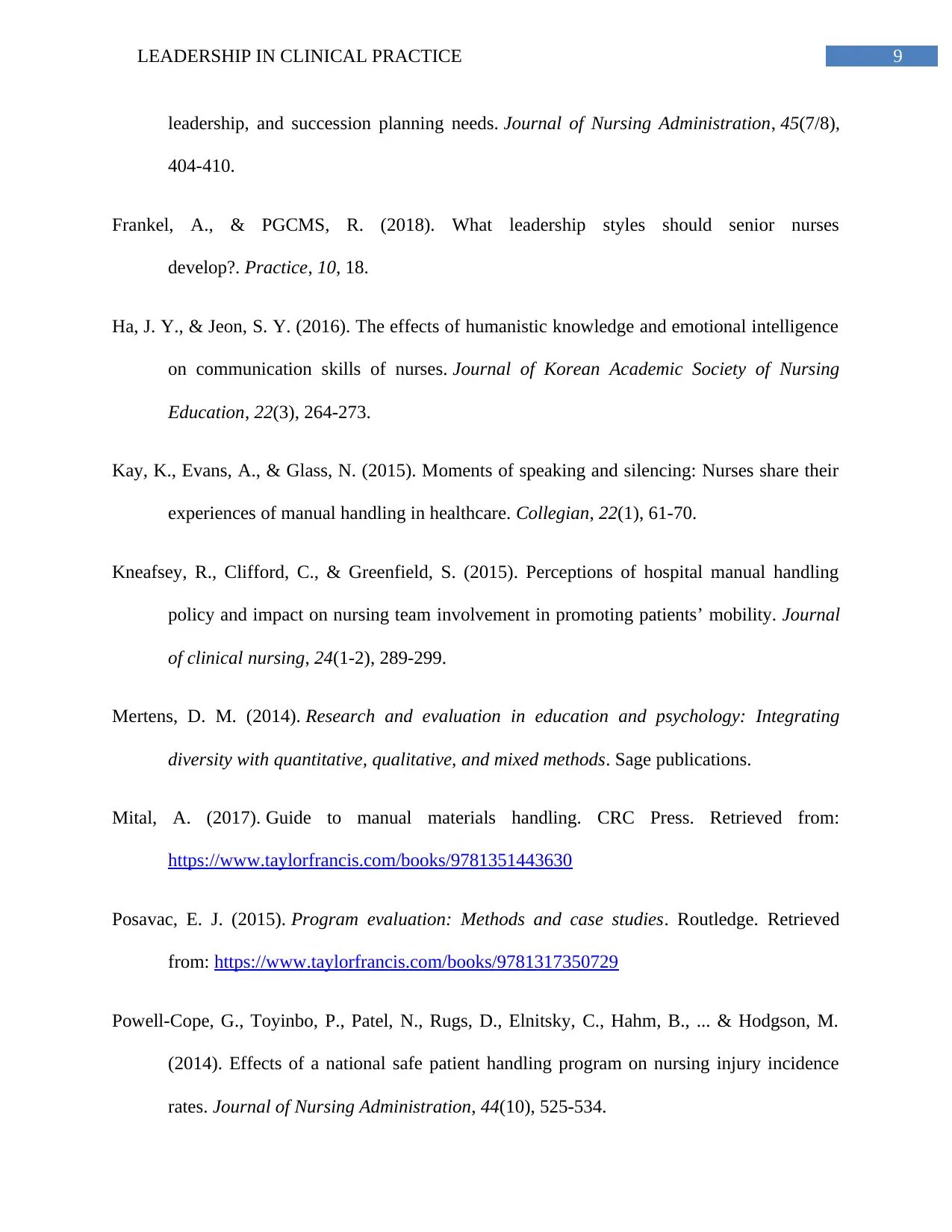
9LEADERSHIP IN CLINICAL PRACTICE
leadership, and succession planning needs. Journal of Nursing Administration, 45(7/8),
404-410.
Frankel, A., & PGCMS, R. (2018). What leadership styles should senior nurses
develop?. Practice, 10, 18.
Ha, J. Y., & Jeon, S. Y. (2016). The effects of humanistic knowledge and emotional intelligence
on communication skills of nurses. Journal of Korean Academic Society of Nursing
Education, 22(3), 264-273.
Kay, K., Evans, A., & Glass, N. (2015). Moments of speaking and silencing: Nurses share their
experiences of manual handling in healthcare. Collegian, 22(1), 61-70.
Kneafsey, R., Clifford, C., & Greenfield, S. (2015). Perceptions of hospital manual handling
policy and impact on nursing team involvement in promoting patients’ mobility. Journal
of clinical nursing, 24(1-2), 289-299.
Mertens, D. M. (2014). Research and evaluation in education and psychology: Integrating
diversity with quantitative, qualitative, and mixed methods. Sage publications.
Mital, A. (2017). Guide to manual materials handling. CRC Press. Retrieved from:
https://www.taylorfrancis.com/books/9781351443630
Posavac, E. J. (2015). Program evaluation: Methods and case studies. Routledge. Retrieved
from: https://www.taylorfrancis.com/books/9781317350729
Powell-Cope, G., Toyinbo, P., Patel, N., Rugs, D., Elnitsky, C., Hahm, B., ... & Hodgson, M.
(2014). Effects of a national safe patient handling program on nursing injury incidence
rates. Journal of Nursing Administration, 44(10), 525-534.
leadership, and succession planning needs. Journal of Nursing Administration, 45(7/8),
404-410.
Frankel, A., & PGCMS, R. (2018). What leadership styles should senior nurses
develop?. Practice, 10, 18.
Ha, J. Y., & Jeon, S. Y. (2016). The effects of humanistic knowledge and emotional intelligence
on communication skills of nurses. Journal of Korean Academic Society of Nursing
Education, 22(3), 264-273.
Kay, K., Evans, A., & Glass, N. (2015). Moments of speaking and silencing: Nurses share their
experiences of manual handling in healthcare. Collegian, 22(1), 61-70.
Kneafsey, R., Clifford, C., & Greenfield, S. (2015). Perceptions of hospital manual handling
policy and impact on nursing team involvement in promoting patients’ mobility. Journal
of clinical nursing, 24(1-2), 289-299.
Mertens, D. M. (2014). Research and evaluation in education and psychology: Integrating
diversity with quantitative, qualitative, and mixed methods. Sage publications.
Mital, A. (2017). Guide to manual materials handling. CRC Press. Retrieved from:
https://www.taylorfrancis.com/books/9781351443630
Posavac, E. J. (2015). Program evaluation: Methods and case studies. Routledge. Retrieved
from: https://www.taylorfrancis.com/books/9781317350729
Powell-Cope, G., Toyinbo, P., Patel, N., Rugs, D., Elnitsky, C., Hahm, B., ... & Hodgson, M.
(2014). Effects of a national safe patient handling program on nursing injury incidence
rates. Journal of Nursing Administration, 44(10), 525-534.
Secure Best Marks with AI Grader
Need help grading? Try our AI Grader for instant feedback on your assignments.
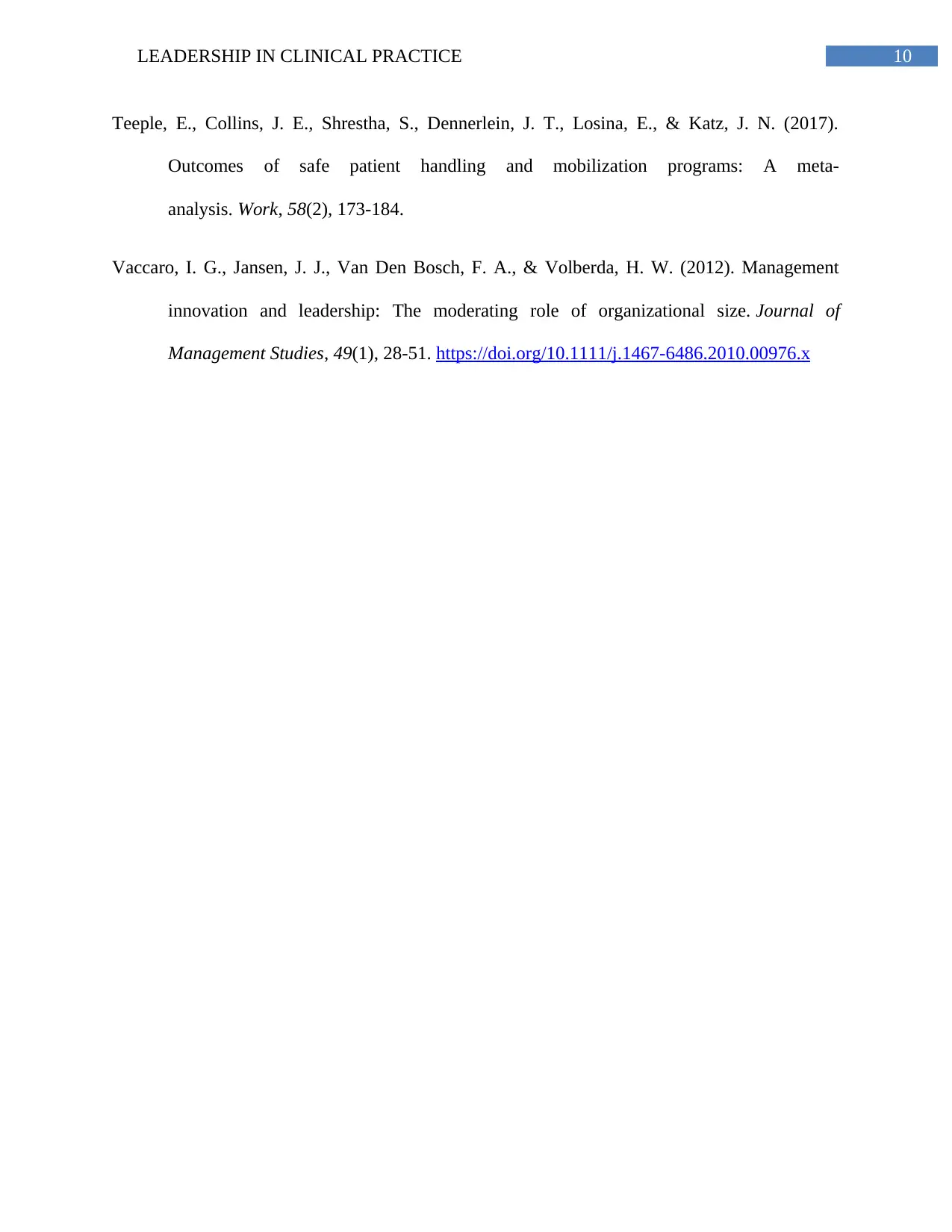
10LEADERSHIP IN CLINICAL PRACTICE
Teeple, E., Collins, J. E., Shrestha, S., Dennerlein, J. T., Losina, E., & Katz, J. N. (2017).
Outcomes of safe patient handling and mobilization programs: A meta-
analysis. Work, 58(2), 173-184.
Vaccaro, I. G., Jansen, J. J., Van Den Bosch, F. A., & Volberda, H. W. (2012). Management
innovation and leadership: The moderating role of organizational size. Journal of
Management Studies, 49(1), 28-51. https://doi.org/10.1111/j.1467-6486.2010.00976.x
Teeple, E., Collins, J. E., Shrestha, S., Dennerlein, J. T., Losina, E., & Katz, J. N. (2017).
Outcomes of safe patient handling and mobilization programs: A meta-
analysis. Work, 58(2), 173-184.
Vaccaro, I. G., Jansen, J. J., Van Den Bosch, F. A., & Volberda, H. W. (2012). Management
innovation and leadership: The moderating role of organizational size. Journal of
Management Studies, 49(1), 28-51. https://doi.org/10.1111/j.1467-6486.2010.00976.x
1 out of 11
Related Documents
Your All-in-One AI-Powered Toolkit for Academic Success.
+13062052269
info@desklib.com
Available 24*7 on WhatsApp / Email
![[object Object]](/_next/static/media/star-bottom.7253800d.svg)
Unlock your academic potential
© 2024 | Zucol Services PVT LTD | All rights reserved.





